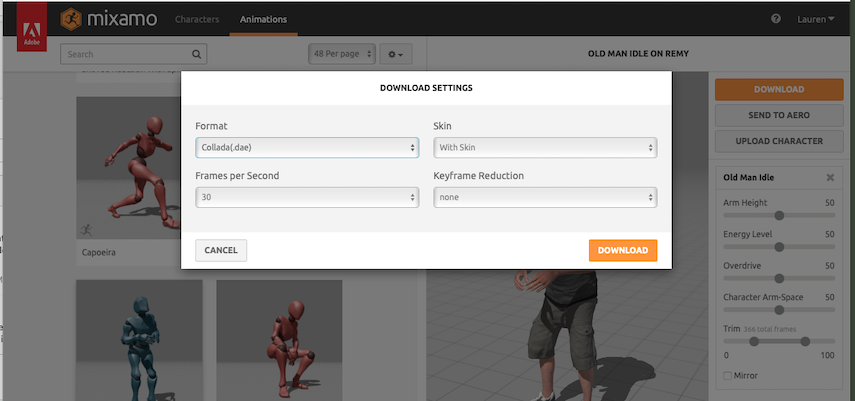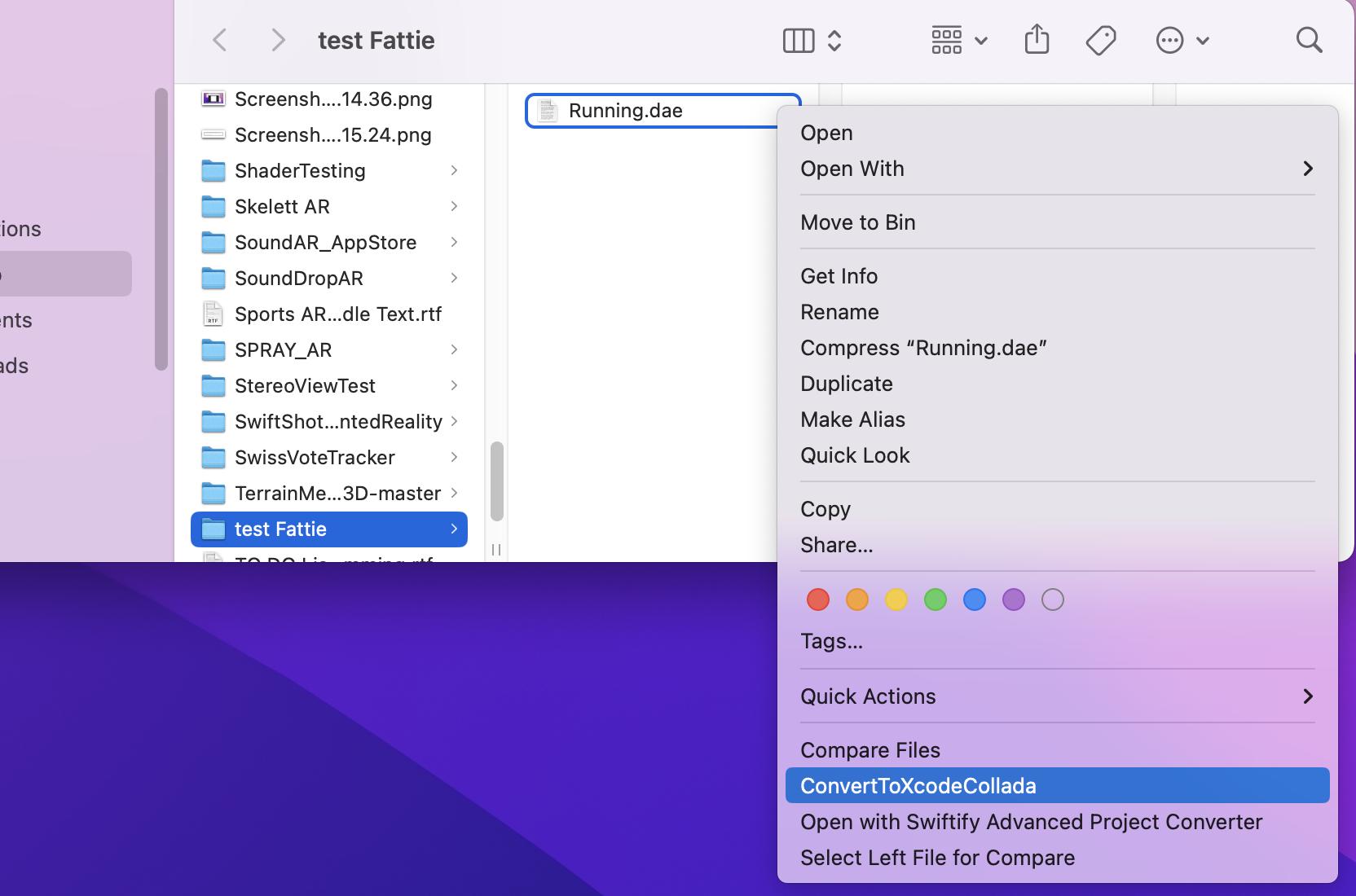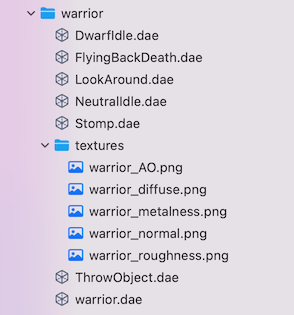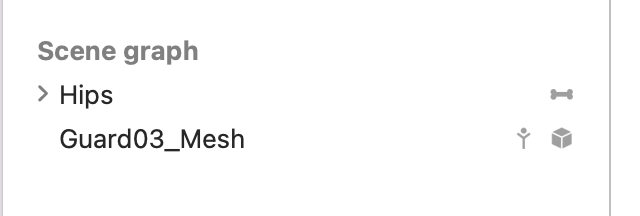First, you need your character in the T-Position only. Download that file as Collada (DAE) with the Skin. Do NOT include any animations to this File. No Further modifications are required to this file then.
Then, for any animation effect you will implement like walking, running, dancing, or whatever - do it like so:
Test/Apply your desired animation in Mixamo on the character, adjust the settings as you want then download it. Here it is very important to Download as Collada (DAE) and choose WITHOUT Skin!!! Leave Framerate and keyframe reduction default.
This will give you a single DAE File for each animation you want to implement. This DAE contains no mesh data and no rig. It only contains the deformations of the Model to which it belongs (this is why you choose to download it without Skin).
Then you need to do two additional operations on all DAE Files which contains animations.
First, you need to pretty-print the XML structure of each DAE containing an animation. You can do this i.Ex. using the XML Tools in Notepad++ or you open a terminal on your Mac and use this command:
xmllint —-format my_anim_orig.dae > my_anim.dae
Then install this Tool here on your Mac.
(https://drive.google.com/file/d/167Le084XFM5euTm4TRItbhXXPVaPJhZN/view?usp=sharing)
![Converter Tool]()
Convert all of your DAE Animations with this converter:
(But do NOT convert your T-Pose Model using this tool!!!)
![Collada converter]()
Now we are ready to setup the Animation:
you should organise the DAE's within the art.scnassets folder
![enter image description here]()
Let's configure this:
I usually organise this within a struct called characters. But any other implementation will do
add this:
struct Characters {
// MARK: Characters
var bodyWarrior : SCNNode!
private let objectMaterialWarrior : SCNMaterial = {
let material = SCNMaterial()
material.name = "warrior"
material.diffuse.contents = UIImage.init(named: "art.scnassets/warrior/textures/warrior_diffuse.png")
material.normal.contents = UIImage.init(named: "art.scnassets/warrior/textures/warrior_normal.png")
material.metalness.contents = UIImage.init(named: "art.scnassets/warrior/textures/warrior_metalness.png")
material.roughness.contents = UIImage.init(named: "art.scnassets/warrior/textures/warrior_roughness.png")
material.ambientOcclusion.contents = UIImage.init(named: "art.scnassets/warrior/textures/warrior_AO.png")
material.lightingModel = .physicallyBased
material.isDoubleSided = false
return material
}()
// MARK: MAIN Init Function
init() {
// Init Warrior
bodyWarrior = SCNNode(named: "art.scnassets/warrior/warrior.dae")
bodyWarrior.childNodes[1].geometry?.firstMaterial = objectMaterialWarrior // character body material
print("Characters Init Completed.")
}
}
Then you can init the struct i.Ex. in the viewDidLoad
var characters = Characters()
Pay Attention to use the correct childNodes!
![child nodes]()
in this case the childNodes[1] is the visible mesh and childNodes[0] then will be the animation Node.
you might also implement this SceneKit extension to your code, it is very useful to import Models. (attention, it will organise the model nodes as Childs from a new node!)
extension SCNNode {
convenience init(named name: String) {
self.init()
guard let scene = SCNScene(named: name) else {return}
for childNode in scene.rootNode.childNodes {addChildNode(childNode)}
}
}
also add that extension below. You'll need it for the animation player later.
extension SCNAnimationPlayer {
class func loadAnimation(fromSceneNamed sceneName: String) -> SCNAnimationPlayer {
let scene = SCNScene( named: sceneName )!
// find top level animation
var animationPlayer: SCNAnimationPlayer! = nil
scene.rootNode.enumerateChildNodes { (child, stop) in
if !child.animationKeys.isEmpty {
animationPlayer = child.animationPlayer(forKey: child.animationKeys[0])
stop.pointee = true
}
}
return animationPlayer
}
}
Handle Character setup and Animation like so:
(here is a simplified version of my Class)
class Warrior {
// Main Nodes
var node = SCNNode()
private var animNode : SCNNode!
// Control Variables
var isIdle : Bool = true
// For Initial Warrior Position and Scale
private var position = SCNMatrix4Mult(SCNMatrix4MakeRotation(0,0,0,0), SCNMatrix4MakeTranslation(0,0,0))
private var scale = SCNMatrix4MakeScale(0.03, 0.03, 0.03) // default size ca 6m height
// MARK: ANIMATIONS
private let aniKEY_NeutralIdle : String = "NeutralIdle-1" ; private let aniMAT_NeutralIdle : String = "art.scnassets/warrior/NeutralIdle.dae"
private let aniKEY_DwarfIdle : String = "DwarfIdle-1" ; private let aniMAT_DwarfIdle : String = "art.scnassets/warrior/DwarfIdle.dae"
private let aniKEY_LookAroundIdle : String = "LookAroundIdle-1" ; private let aniMAT_LookAroundIdle : String = "art.scnassets/warrior/LookAround.dae"
private let aniKEY_Stomp : String = "Stomp-1" ; private let aniMAT_Stomp : String = "art.scnassets/warrior/Stomp.dae"
private let aniKEY_ThrowObject : String = "ThrowObject-1" ; private let aniMAT_ThrowObject : String = "art.scnassets/warrior/ThrowObject.dae"
private let aniKEY_FlyingBackDeath : String = "FlyingBackDeath-1" ; private let aniMAT_FlyingBackDeath : String = "art.scnassets/warrior/FlyingBackDeath.dae"
// MARK: MAIN CLASS INIT
init(index: Int, scaleFactor: Float = 0.03) {
scale = SCNMatrix4MakeScale(scaleFactor, scaleFactor, scaleFactor)
// Config Node
node.index = index
node.name = "warrior"
node.addChildNode(GameViewController.characters.bodyWarrior.clone()) // childNodes[0] of node. this holds all subnodes for the character including animation skeletton
node.childNodes[0].transform = SCNMatrix4Mult(position, scale)
// Set permanent animation Node
animNode = node.childNodes[0].childNodes[0]
// Add to Scene
gameScene.rootNode.addChildNode(node) // add the warrior to scene
print("Warrior initialized with index: \(String(describing: node.index))")
}
// Cleanup & Deinit
func remove() {
print("Warrior deinitializing")
self.animNode.removeAllAnimations()
self.node.removeAllActions()
self.node.removeFromParentNode()
}
deinit { remove() }
// Set Warrior Position
func setPosition(position: SCNVector3) { self.node.position = position }
// Normal Idle
enum IdleType: Int {
case NeutralIdle
case DwarfIdle // observe Fingers
case LookAroundIdle
}
// Normal Idles
func idle(type: IdleType) {
isIdle = true // also sets all walking and running variabled to false
var animationName : String = ""
var key : String = ""
switch type {
case .NeutralIdle: animationName = aniMAT_NeutralIdle ; key = aniKEY_NeutralIdle // ; print("NeutralIdle ")
case .DwarfIdle: animationName = aniMAT_DwarfIdle ; key = aniKEY_DwarfIdle // ; print("DwarfIdle ")
case .LookAroundIdle: animationName = aniMAT_LookAroundIdle ; key = aniKEY_LookAroundIdle // ; print("LookAroundIdle")
}
makeAnimation(animationName, key, self.animNode, backwards: false, once: false, speed: 1.0, blendIn: 0.5, blendOut: 0.5)
}
func idleRandom() {
switch Int.random(in: 1...3) {
case 1: self.idle(type: .NeutralIdle)
case 2: self.idle(type: .DwarfIdle)
case 3: self.idle(type: .LookAroundIdle)
default: break
}
}
// MARK: Private Functions
// Common Animation Function
private func makeAnimation(_ fileName : String,
_ key : String,
_ node : SCNNode,
backwards : Bool = false,
once : Bool = true,
speed : CGFloat = 1.0,
blendIn : TimeInterval = 0.2,
blendOut : TimeInterval = 0.2,
removedWhenComplete : Bool = true,
fillForward : Bool = false
)
{
let anim = SCNAnimationPlayer.loadAnimation(fromSceneNamed: fileName)
if once { anim.animation.repeatCount = 0 }
anim.animation.autoreverses = false
anim.animation.blendInDuration = blendIn
anim.animation.blendOutDuration = blendOut
anim.speed = speed; if backwards {anim.speed = -anim.speed}
anim.stop()
print("duration: \(anim.animation.duration)")
anim.animation.isRemovedOnCompletion = removedWhenComplete
anim.animation.fillsForward = fillForward
anim.animation.fillsBackward = false
// Attach Animation
node.addAnimationPlayer(anim, forKey: key)
node.animationPlayer(forKey: key)?.play()
}
}
you can then initialise the Class Object after you initialised the characters struct.
the rest you'll figure out, come back on me, if you have questions or need a complete example App :)





